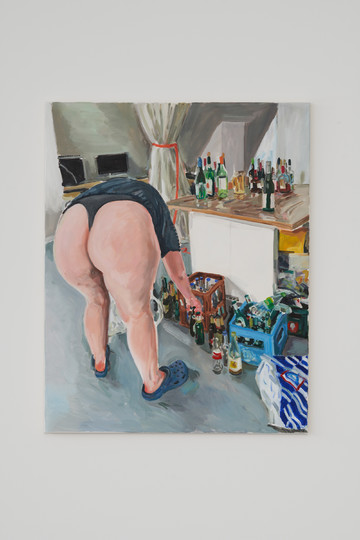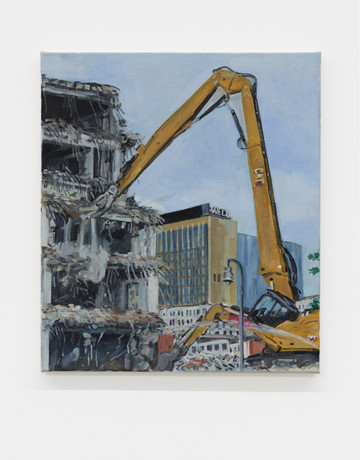For Elizabeth Ravn painting is about the notions of time and of change, of confronting the everyday and its simultaneous conscious and unconscious associations. Since 2017, when the artist moved to Berlin from her hometown of New York City, after receiving her BFA from the School of the Art Institute of Chicago, she has painted intimate scenes of those close to her—including her partner and queer friends in Berlin—in domestic and architectural spaces. Her expertly executed, defined strokes and saturated yet realistic color pallets render fleeting impressions of the world as it exists from her perspective, offering moments frozen in time.
Looking at Picnic for Stix (2023), two people and a dog are seen lounging on lush green grass next to Tupperwares filled with food and flowers in glass-bottles-cum-vases atop a white blanket. In Cash Out (2023), a young adult, hair tied back in a loose bun and wearing an oversized black coat, withdraws cash from a Euronet ATM, the blue glow of the screen illuminating their unseen face. In Tidy (2023), someone wearing a black thong, Crocs, and T-shirt bends over to put beer bottles in a plastic bag, seemingly the morning after a party, the counter littered with additional detritus. To some viewers, such subject matter might feel very relatable, while to others, it has the potential to feel foreign—for the context of Ravn’s paintings is specific to her own gaze; to a precise place and time.
Beyond the people shown, the buildings in Ravn’s paintings have strong voices, too: in constantly reconstructed cities, buildings are markers of history, time, and change. In a 2022 series, Ravn documented buildings in Berlin that eventually might not exist alongside scaffolding, construction sites, and housing developments, subtly addressing the flux of real estate and gentrification in the German capital. Although her paintings are indeed static—and often show their subjects in moments of rest and stasis—everything, even if behind-the-scenes, is always changing. As the headline of a recent report on Berlin’s art ecosystem in Frieze read, “Out with Punk and in with Prada.”
More than painting those in her community, Ravn often commissions friends to craft texts to accompany her exhibitions. In one such fictional narrative, Zayne Armstrong wrote: “I’ve been having these flashes of disorientation […] while I’m awake, where, for a split second I can’t remember basic things like who I am, where I am, what story I’m part of, and then like, ‘Oh right I’m brushing my teeth.’” Looking at the artist’s paintings can produce a similar kind of simultaneous familiarity and disorientation: standing in a room, looking at paintings, the viewer becomes absorbed by the potential storylines, trying to figure out where they themselves might fit or what story they might be part of.
Emily McDermott, 2023

Oil on canvas
110 × 140 cm

Oil on canvas
90 x 110 cm

Oil on canvas
90 × 80 cm

Oil on canvas
100 x 80 cm

Oil on canvas
80 x 100 cm

Oil on canvas
65 x 55 cm

Oil on canvas
40 × 50 cm

Oil on canvas
50 × 40 cm

Oil on canvas
70 × 60 cm

Oil on canvas
55 × 60 cm

Oil on canvas
55 x 66 cm

Oil on canvas
100 x 80 cm

Oil on canvas
70 x 50 cm

Oil on canvas
100 x 90 cm

Oil on canvas
40 x 50 cm

Oil on canvas
100 x 80 cm

Oil on canvas
65 x 55 cm

Oil on canvas
60 x 80 cm

Oil on canvas
80 x 70 cm

Oil on canvas
80 x 100 cm

Oil on canvas
55 x 45 cm

